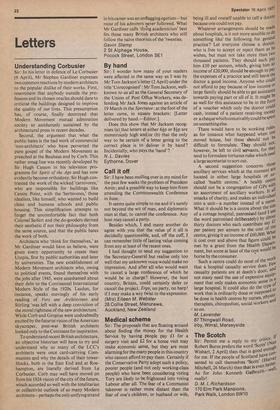Understanding Corbusier
Sir: In his letter in defence of Le Corbusier (9 April), Mr Stephen Gardiner expresses two common reactions by modern architects to the popular dislike of their works. First, resentment that anybody outside the profession and its chosen oracles should dare to criticise the buildings designed to improve the quality of our lives. This presumption has, of course, finally destroyed that Modern Movement mutual admiration society so assiduously sustained by the architectural press in recent decades.
Second, the argument that what the public hates is the bad work of commercial 'non-architects' who have perverted the pure gospel of the Modern Movement as preached at the Bauhaus and by Corb. This rather smug line was recently developed by Sir Hugh Casson in his television programme for Spirit of the Age and has now evidently become orthodoxy. Sir Hugh contrasted the work of the wicked 'carnivores,' who are responsible for buildings like Centre Point, with the 'herbivores,' those idealists, like himself, who wanted to build clean and humane schools and public housing. This simplification attempts to forget the uncomfortable fact that both Colonel Seifert and the do-gooders derived their aesthetic if not their philosophy from the same source, and that the public hates the work of both.
Architects who 'think for themselves,' as Mr Gardiner would have us believe, were given every opportunity to create their Utopia, first by public authorities and later by universities. The new establishment of Modern Movement architects who, owing to political events, found themselves with the jobs after 1945, were unashamed about their debt to the Continental International Modern Style of the 1920s. Lasdun, for instance, speaks movingly of his early reading of Vers une Architecture. and Stirling 'was left with a deep conviction of the moral rightness of the new architecture.' While Corb and Gropius were undoubtedly excited by the futurist vision of the American skyscraper, post-war British architects looked only to the Continent for inspiration.
To understand recent British architecture, an objective historian will have to try and understand why so many of the LCC's architects were once card-carrying Communists and why the details of their towerblocks, both in the East End and at Roehampton, are literally derived from Le Corbusier. Corb may well have moved on from his 1924 vision of the city of the future, which accorded so well with the totalitarian or collectivist outlook of so many Modern architects—perhaps the only unifying strand
in his career was an unflagging egotism—but most of his admirers rlever followed. What Mr Gardiner calls 'dying academicism' best fits those many British architects who still follow the naive theorists of the 'twenties. Gavin Stamp
2 St Alphege House, Pocock Street, London SEI






































 Previous page
Previous page